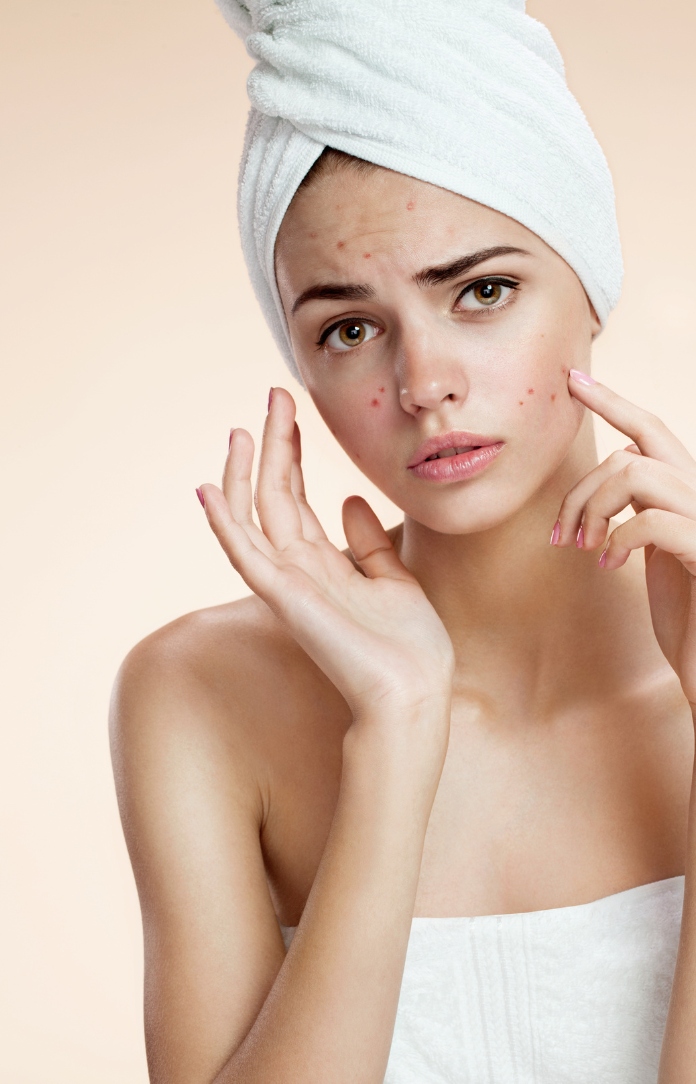Not all acne is created equal. Namely, there are several different types of acne, and the most efficient treatment of this pesky skin condition depends on its type.
However, there is one common thing for all acne, and that is the fact they are all caused by some irregularities of the pilosebaceous units. Your pilosebaceous unit consists of several elements:
- A hair follicle
- A hair shaft
- Sebaceous glands
Sebaceous glands secrete the sebum into the hair follicle. Sebum is the oily matter that keeps your skin moisturized. Once the hair follicle is full of sebum, it oozes out and spreads over the skin keeping it beautiful and glowy.
If the sebaceous glands overproduce the sebum, then we are talking about oily skin and hair. There is another issue with hair follicles. Just as the sebum can get out of the follicle, dead skin cells, dirt, and other items can enter the follicle. That’s when the issues arise.

Depending on the issue that happens to the pilosebaceous unit, we can have six different types of acne. Let’s look into every one of them.
Ordinary pimple (Inflammatory papule)
When you are thinking about acne, the first thing you probably think about is the ordinary, inflamed, red bump that happens in the worst possible moment in your life. The experts call your regular red pimple – inflammatory papule. This is how it comes to existence and what to do when it happens.
Why do they happen?
We already said that there is a lot of material entering the hair follicle, as well. So, you have a hair follicle that already contains sebum. There is an excessive amount of dead skin cells and other material building up. Sooner or later, the follicle walls give in, and they break.
What happens is that the sebum and all that material enter the surrounding tissue. What causes the issue there is the bacteria that is common in your skin. It is called P. acnes. It infects the surrounding tissue, and that is how the redness and the outbreak start.
What to do?
There are two ways to approach this problem. You can either try and reduce the stickiness of the cells so that you prevent the buildup in the hair canal, or you can try and deal with the bacteria.
To prevent the stickiness of the cells, you can use over-the-counter salicylic acid or prescription tretinoin products. If you want to kill the bacteria, then go for over-the-counter benzoyl peroxide or topical antibiotic creams that kill P. acnes. If you have too many pimples, your doctor may prescribe oral antibiotics.
Pustule
Everything that has been said about the ordinary pimple goes for the pustule, as well. However, there is one slight difference that makes it a separate class of acne. Namely, a pustule is the same as a pimple, but it contains the white blood cells, as well.
Why do they happen?
What happens is that the white cells attach the P. acnes bacteria within the pimple. That creates even greater buildup. Moreover, the excess of white cells also creates the pus that is characteristic for the pustule.

What to do?
The treatment is the same as with the ordinary pimple.
Early acne (Microcomedone)
There have been a lot of tears shed due to early acne. There are quite a few of the unfortunate ones who had to deal with the acne in their youth. It is evident that the hormones have something to do with this type of outbreak, but let’s get a bit more into the mechanics of their origin.
Why do they happen?
The process is similar to that of the ordinary pimple, but it still has some differences. The skin cells that shed are called corneocytes. Typically, they are not sticky, and they flow with the sebum outside. However, sometimes they become sticky, and they accumulate. They block the sebum flow, creating a bottleneck.
This is when the bacteria P. acnes start to grow because they feed on sebum. Excess sebum – the excess of bacteria. Consequently, the entire follicle becomes inflamed.
What to do?
You should reach for tretinoin or salicylic acid lotions to reduce the stickiness of the cells. Your other option is to use benzoyl peroxide to stop the overpopulation of the P. acnes.
Cyst or Nodule
Cysts are maybe the most painful and the most aesthetically problematic types of acne. Namely, they involve some scarring and even a bit of blood. They are almost impossible to cover up, and every attempt of doing so can make them worse.
Why do they happen?
Just like the early acne, there is an excessive buildup of corneocytes and the sebum. This must be a massive buildup that not only spills into the surrounding tissue but also creates scares and even a bit of bleeding. A very painful cyst is also formed.
What to do?
It is usually too late, at this stage, for the over-the-counter products. You will need to use products that reduce the stickiness of the cells, but also topical and oral antibiotics. In addition to that, some doctors prescribe Accutane. People who use this medicine need to be closely monitored due to adverse side effects.
Whiteheads and Blackheads
Let’s discuss these two together because the only difference between them is the fact that the blackheads are in an open pore while the whiteheads are in a closed pore.
Why do they happen?
As with all other types of acne, the problem is the buildup of the sebaceous material. What makes the whiteheads and blackheads different is the consistency of this type of content. It becomes firm and thick. If the pore remains open – we are dealing with a blackhead, easily recognized by its color. The closed pore will form a whitehead in the same circumstances.
What to do?
You should take some of the salicylic acid based lotion to prevent the stickiness of the cells, but also to prevent the buildup from being so firm and consistent. Benzoyl peroxide will kill the bacteria and stop the infection. These are the over-the-counter options. Your prescribed options are tretinoin-based products and topical antibiotics.
As you can see, treating the acne is all about keeping the corneocytes not sticky and maintaining healthy levels of bacteria within your follicles. Regular facial hygiene and proper skin care routines will help you maintain beautiful and clean skin that is acne-free.

